Less Is More: Audience Cognition of Comic Simplification in the Characters of Peking Opera
Abstract
:1. Introduction
- This study is aimed at exploring how comic creation can be used to simplify the character of opera characters, and to study whether the audiences can understand the creator’s motivation and ideas. Meanwhile, the factors affecting the evaluation of works of art will also be studied.
- As a series of studies, the simplification used in this study is just the first step in testing the usefulness of simplification as a creative method. This also shows that the aim of this study is to simplify the application of the philosophy of “less is more, more is confused” in the creation of Peking opera, which deserves further discussion and review.
2. Literature Review
2.1. Visual Features for Icon Design
- Shape Feature. A shape characteristic acts as an example of a general class of objects. A form function is not an exact copy of a form of an object, but rather a reflection of the relevant qualities of an object.
- Function Feature. A function is used to get designers to look for structural principles in the design to create their own pictures. The result of the design derived from the functionality is involved in a particular action as necessary as the conclusion of a geometry theorem.
- Image Features. A picture function attempts to present a concept to a spectator who is outside the real picture. The graphic form represents the perceptive content of an object or concept that it represents. Image functionality is not the intent of this design style to show the form of an object. On the other hand, the image function is designed to transmit the image of an object—an image at a higher level of abstraction than the symbol itself.
2.2. Levels of Stylization
2.3. Communication Matrix
2.4. Simplicity of Chinese Paintings
- Transfer Features to Form. The central idea is objective representation and direct expression, underscoring the basis of the form and respecting the shape of the object. Such a way of manifesting is to obtain a lively resemblance to the “form” of the characters.
- Transform Features to Spirit. In general, the form is the bearer of the spirit. Without the form, the spirit will not be transmitted at all. Form and spirit are related to preponderance and subordination. Painters must manifest the intrinsic essence of a figure and follow the mind through the shape of the painting.
- Reflect Spirit to Semantics. As Xie [17] said: “Spirit Resonance, or the vitality, and seems to translate to the nervous energy transmitted from the artist into the work. If a painting is without ‘spirit resonance’, there is no need to look further”. Likewise, where encounters of comic creation are implicit elements of opera, it will add some semantic effects. The form and spirit of the opera will form symbolic images and underline the implicit features of opera culture.
- Ignore Form to Essence. Traditional Chinese philosophy is a poetic philosophy and an artistic philosophy which follows “implication beyond lines”, “image beyond pictures”, and “intention beyond tastes”. In traditional Chinese aesthetics and philosophy, they often attach great importance to the concepts and ignore forms. In this last principle, the focus is on how to outline the character with the simple lines, while retaining the rich dramatic connotation and the spirit behind the character. In short, the form is the simplest and the content is the most abundant.
3. Method
3.1. Research Framework
3.2. Procedure
3.3. Samples
3.4. Questionnaire
3.5. Participants
4. Results and Discussion
4.1. Evaluation of Overall
4.2. Discussion
- From different evaluation attributes, we can find: (1) In “Attribute 1”, there is not any difference between simplifying 3 and 4. The results of multiple comparisons between other groups were II-2 > II-1, II-3 > II-1, II-4 > II-1, II-2 > II-3, and II-2 > II-4. (2) In “Attribute 2”, there are differences in simplify 1 and 3, simplify 2 and 3, and simplify 2 and 4. The results of multiple comparisons between other groups were as follows: II-1 > II-3, II-2 > II-3, and II-2 > II-4. (3) In “Attribute 3”, there is not any difference between simplify 3 and 4. The results of multiple comparisons between other groups were II-1 > II-2, II-1 > II-3, II-1 > II-4, II-3 > II-2, and II-4 > II-2. (4) In “Attribute 4”, there is not any difference between simplify 3 and 4. The results of multiple comparisons between other groups were II-1 > II-2, II-1 > II-3, II-1 > II-4, II-3 > II-2, and II-4 > II-2.
- From different simplification stages, we can find: (1) In “Stage 1”, there is no difference between attribute 3 and 4. The results of multiple comparisons between other groups were I-2 > I-1, I-3 > I-1, I-4 > I-1, I-3 > I-2, and I-4 > I-2. (2) In “Stage 2”, there is no difference except between attribute 3 and 4. The results of multiple comparisons between other groups were I-1 > I-2, I-1 > I-3, I-1 > I-4, I-2 > I-3, and I-2 > I-4. (3) In “Stage 3”, the differences are only between attribute 1 and 3. The results of multiple comparisons between other groups are as follows: I-4 > I-3. (4) In “Stage 4”, there are differences in attributes 1 and 3 and attributes 2 and 3. The results of multiple comparisons between other groups were as follows: I-1 > I-3 and I-2 > I-3.
- It can be seen from Figure 7 and Figure 8 that (1) Between the images of the first two stages of simplification, except for the similar evaluation on the second attribute, there are big differences in the other three attributes. Nevertheless, the two images have a certain point of continuity, no matter how they are expressed or simplified, which is why such a large difference in cognition is worthy of further study. (2) The images of the last two stages of simplification have very similar evaluations on all attributes, and there is not much fluctuation. In terms of details, the score of stage 4’s image is comparatively high. The above results can explained: In terms of the “simplification” itself, the perception that participants have of the simplified image is relatively stable. However, they do not like images that are too simplified (close to symbols). This is in agreement with the results in Table 5.
5. Conclusions and Suggestions
- The audience did not like images that were simplified to the extreme, which tended to be symbolic. They preferred samples which retain the main features of the original and underwent artistic treatment with a certain simplification.
- For the creators of this article, simplified creative ideas are feasible, but it is necessary to choose suitable and appropriate simplified processing methods according to different objects in order to let viewers understand the creator’s intentions.
- In this study, because of differences in gender, age, education, and background of the viewers, there will also be separate cognitive differences between them. This can be explored in future research. The audience of traditional opera is relatively certain and may be mainly middle-aged and older people who like traditional culture. For creators and researchers, attracting interest from other groups has become a very interesting and significant issue. Simplified imaginative thinking in the form of comics can play a role and can also be an inspiration to other researchers.
- The samples selected in this study have adopted the same simplified model and creative style. Participants may experience visual fatigue when answering outstanding questions. In future research, we may expand the size of the comparison group. Additionally, the author plans to add more characters from the Peking Opera to the research sample. This can reduce the cognitive limitations of a single sample type to better capture participant preferences and trends through comparison.
- The evaluation criteria for this article are jointly influenced by Chinese philosophy, Chinese painting theory, and Mies’s design thought. However, most respondents always use subjective intuition as the basis for their judgement. Therefore, it is not easy to explain the connotation of the artwork from a “scientific” perspective. Simplification is not the only way to “Less is more, More is confused” because simplification is a trade-off process. Future comic creators will need to consider how to reduce the details of the creation process, but still enable the audience to “get” the whole appearance of people. This also shows that the aim of this study is to simplify the application of the philosophy of “Less is more, More is confused” in the creation of opera, which deserves further discussion and review.
Author Contributions
Funding
Institutional Review Board Statement
Informed Consent Statement
Data Availability Statement
Conflicts of Interest
Appendix A
| Part 1: Evaluation of Attribute Based on the following four attributes; please subjectively evaluate the strength of the attributes corresponding to each work in the four stages of each comic work in the simplified process. Here are four groups of comics in total, and each group of comic has four images in different simplified processes. Every image needs to be answered to the same questions regarding the four attributes. | |
| Sample and the four stages of simplification | Evaluation attributes and scoring standard |
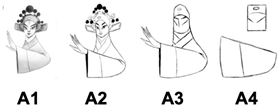 | 1. Simple Appearance Very unfit ☐1 ☐2 ☐3 ☐4 ☐5 Very fit 2. Expression Control Very unfit ☐1 ☐2 ☐3 ☐4 ☐5 Very fit 3. Bold Exaggeration Very unfit ☐1 ☐2 ☐3 ☐4 ☐5 Very fit 4. Creative Performance Very unfit ☐1 ☐2 ☐3 ☐4 ☐5 Very fit |
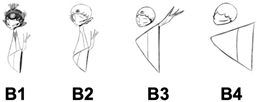 | 1. Simple Appearance Very unfit ☐1 ☐2 ☐3 ☐4 ☐5 Very fit 2. Expression Control Very unfit ☐1 ☐2 ☐3 ☐4 ☐5 Very fit 3. Bold Exaggeration Very unfit ☐1 ☐2 ☐3 ☐4 ☐5 Very fit 4. Creative Performance Very unfit ☐1 ☐2 ☐3 ☐4 ☐5 Very fit |
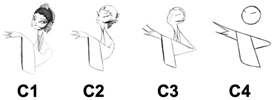 | 1. Simple Appearance Very unfit ☐1 ☐2 ☐3 ☐4 ☐5 Very fit 2. Expression Control Very unfit ☐1 ☐2 ☐3 ☐4 ☐5 Very fit 3. Bold Exaggeration Very unfit ☐1 ☐2 ☐3 ☐4 ☐5 Very fit 4. Creative Performance Very unfit ☐1 ☐2 ☐3 ☐4 ☐5 Very fit |
 | 1. Simple Appearance Very unfit ☐1 ☐2 ☐3 ☐4 ☐5 Very fit 2. Expression Control Very unfit ☐1 ☐2 ☐3 ☐4 ☐5 Very fit 3. Bold Exaggeration Very unfit ☐1 ☐2 ☐3 ☐4 ☐5 Very fit 4. Creative Performance Very unfit ☐1 ☐2 ☐3 ☐4 ☐5 Very fit |
| Part 2 and 3: Evaluation of Preferences I and II Based on the following nine questions, select the image you think is most suitable. | |
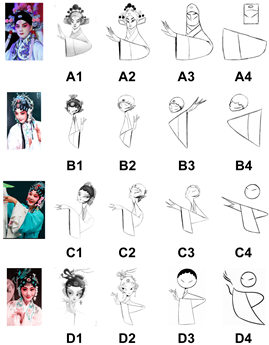 | Evaluation of preferences I 1. Which image is simplified to a most appropriate degree do you think? ☐A1 ☐A2 ☐A3 ☐A4 ☐B1 ☐B2 ☐B3 ☐B4 ☐C1 ☐C2 ☐C3 ☐C4 ☐D1 ☐D2 ☐D3 ☐D4 2. Which image can best express the creativity? ☐A1 ☐A2 ☐A3 ☐A4 ☐B1 ☐B2 ☐B3 ☐B4 ☐C1 ☐C2 ☐C3 ☐C4 ☐D1 ☐D2 ☐D3 ☐D4 3. Which image shows the richest elements of a cartoon? ☐A1 ☐A2 ☐A3 ☐A4 ☐B1 ☐B2 ☐B3 ☐B4 ☐C1 ☐C2 ☐C3 ☐C4 ☐D1 ☐D2 ☐D3 ☐D4 4. Which image has the best overall expression? ☐A1 ☐A2 ☐A3 ☐A4 ☐B1 ☐B2 ☐B3 ☐B4 ☐C1 ☐C2 ☐C3 ☐C4 ☐D1 ☐D2 ☐D3 ☐D4 5. Which image you like best in terms of expression approach? ☐A1 ☐A2 ☐A3 ☐A4 ☐B1 ☐B2 ☐B3 ☐B4 ☐C1 ☐C2 ☐C3 ☐C4 ☐D1 ☐D2 ☐D3 ☐D4 Evaluation of preferences II 6. Which image do you think stresses the resemblance of “form” on the basis of form? ☐A1 ☐A2 ☐A3 ☐A4 ☐B1 ☐B2 ☐B3 ☐B4 ☐C1 ☐C2 ☐C3 ☐C4 ☐D1 ☐D2 ☐D3 ☐D4 7. Which image conveys the spirit with the use of skillful techniques and emotional experience? ☐A1 ☐A2 ☐A3 ☐A4 ☐B1 ☐B2 ☐B3 ☐B4 ☐C1 ☐C2 ☐C3 ☐C4 ☐D1 ☐D2 ☐D3 ☐D4 8. Which image highlights the cultural characteristics by forming visual images of symbols through form and spirit? ☐A1 ☐A2 ☐A3 ☐A4 ☐B1 ☐B2 ☐B3 ☐B4 ☐C1 ☐C2 ☐C3 ☐C4 ☐D1 ☐D2 ☐D3 ☐D4 9. Which image reflects the conception and neglects the form and becomes an objective symbolic image? ☐A1 ☐A2 ☐A3 ☐A4 ☐B1 ☐B2 ☐B3 ☐B4 ☐C1 ☐C2 ☐C3 ☐C4 ☐D1 ☐D2 ☐D3 ☐D4 |
Appendix B
| 1. “Spirit Resonance”, or vitality, and seems to translate to the nervous energy transmitted from the artist into the work. The overall energy of a work of art. Xie said that without Spirit Resonance, there was no need to look further. |
| 2. “Bone Method”, or the way of using the brush. This refers not only to texture and brush stroke, but to the close link between handwriting and personality. In his day, the art of calligraphy was inseparable from painting. |
| 3. “Correspondence to the Object”, or the depicting of form, which would include shape and line. |
| 4. “Suitability to Type”, or the application of color, including layers, value, and tone. |
| 5. “Division and Planning”, or placing and arrangement, corresponding to composition, space, and depth. |
| 6. “Transmission by Copying”, or the copying of models, not only from life but also the works of antiquity. |
References
- Hohne, K. The Essential I Ching: 64 Degrees of Nature’s Wisdom; Way of Tao Books: Carnelian Bay, CA, USA, 2015. [Google Scholar]
- Chernev, A. When More is Less and Less is More: The Role of Ideal Point Availability and Assortment in Consumer Choice. J. Consum. Res. 2003, 30, 170–183. [Google Scholar] [CrossRef]
- Norton, M.I.; Frost, J.H.; Ariely, D. Less is More: The Lure of Ambiguity, or Why Familiarity Breeds Contempt. J. Pers. Soc. Psychol. 2007, 92, 97–105. [Google Scholar] [CrossRef] [PubMed] [Green Version]
- Ayu, P. Designing Caricature in Teaching Writing for EFL Learners. Res. Engl. Educ. J. 2016, 1, 1–9. [Google Scholar]
- Browne, J.E. Darwin in Caricature: A Study in the Popularisation and Dissemination of Evolution. Proc. Am. Philos. Soc. 2001, 145, 496–509. [Google Scholar]
- Medley, S. Discerning Pictures: How We Look at and Understand Images in Comics. Stud. Comics 2010, 1, 53–70. [Google Scholar] [CrossRef]
- Lin, R. A Study of Visual Features for Icon Design. Des. Stud. 1994, 15, 185–197. [Google Scholar] [CrossRef]
- Lin, R. A Study of Nature Form for Basic Design Instruction. J. Technol. 1987, 2, 17–24. [Google Scholar]
- Meyer, R.P.; Laveson, J.I.; Puls, D. An Experience-Judgement Approach to Tactical Flight Training. Proc. Hum. Factors Soc. Annu. Meet. 1981, 25, 657–660. [Google Scholar] [CrossRef]
- Washburn, D.K. Structure and Cognition in Art; Cambridge University Press: Cambridge, MA, USA, 1983. [Google Scholar]
- Wang, R.W.; Hsu, C.C. Study of the Design Operation of Graphic Simplification. Des. J. 2007, 10, 54–75. [Google Scholar] [CrossRef]
- Wang, R.W.; Hsu, C.C. The Method of Graphic Abstraction in Visual Metaphor. Visible Lang. 2007, 41, 284–297. [Google Scholar]
- Hsu, C.C.; Wang, R.W. The Relationship Between Shape Features and Degrees of Graphic Simplification. J. Des. 2010, 15, 87–105. [Google Scholar]
- Papanek, V. Design for the Real World; Academy Chicago Publishers: Chicago, IL, USA, 1985. [Google Scholar]
- Importance of Communication in the Design Process. Available online: https://uxdesign.cc/importance-of-communication-in-the-design-process-b686b5885623 (accessed on 21 March 2021).
- Lin, R.; Qian, F.D.; Wu, J.; Fang, W.T.; Jin, Y.G. A Pilot Study of Communication Matrix for Evaluating Artworks. Cross-Cult. Des. 2017, 356–368. [Google Scholar] [CrossRef]
- China: A Cultural and Historical Dictionary; Dillon, M. (Ed.) Curzon Press: London, UK, 1998. [Google Scholar]
- Bai, Q.S. Image as Word: A Study of Rebus Play in Song Painting (960-1279). Metrop. Mus. J. 1999, 34, 57–72. [Google Scholar] [CrossRef]
- Murch, A. Words in Chinese Painting. In A companion to Chinese Art; Powers, M.J., Tsiang, K.R., Eds.; John Wiley & Sons: Hoboken, NJ, USA, 2015; pp. 457–474. [Google Scholar]
- Silbergeld, J. Chinese Concepts of Old Age and Their Role in Chinese Painting, Painting Theory, and Criticism. Art J. 1987, 46, 103–114. [Google Scholar] [CrossRef]
- Binyon, L. The Flight of the Dragon: An Essay on the Theory and Practice of Art in China and Japan, Based on Original Sources; John Murray: London, UK, 1911. [Google Scholar]
- Briessen, F.V. The Way of the Brush: Painting Techniques of China and Japan; Tuttle: Rutland, UK, 1962. [Google Scholar]
- Craig, R.T. Communication Theory as a Field. Commun. Theory 1999, 9, 119–161. [Google Scholar] [CrossRef]
- Fiske, J. Introduction to Communication Studies; Routledge: London, UK, 2010. [Google Scholar]
- Jakobson, R. Language in Literature; Harvard University Press: Cambridge, MA, USA, 1987. [Google Scholar]
- Lin, R. Transforming Taiwan Aboriginal Cultural Features into Modern Product Design: A Case Study of a Cross-cultural Product Design Model. Int. J. Des. 2007, 1, 45–53. [Google Scholar]
- Goldstein, J. Mei Lanfang and the Nationalization of Peking Opera, 1912-1930. East Asian Cult. Crit. 1999, 7, 377–420. [Google Scholar] [CrossRef]
- Halson, E. Peking Opera: A Short Guide; Oxford University Press: Oxford, UK, 1966. [Google Scholar]
- Peking Opera. Available online: https://en.wikipedia.org/wiki/Peking_opera#Performers_and_roles (accessed on 2 April 2021).
- Lin, C.L.; Chen, J.L.; Chen, S.J.; Lin, R. The Cognition of Turning Poetry into Painting. J. US-China Educ. Rev. B 2015, 5, 471–487. [Google Scholar] [CrossRef] [Green Version]
- Comrey, A.L. Factor-analytic Methods of Scale Development in Personality and Clinical Psychology. J. Consult. Clin. Psychol. 1988, 56, 754–761. [Google Scholar] [CrossRef] [PubMed]
- Tinsley, H.E.; Tinsley, D.J. Uses of Factor Analysis in Counseling Psychology Research. Couns. Psychol. 1987, 34, 414–424. [Google Scholar] [CrossRef]
- Wu, M.L.; Tu, J.T. SPSS & The Application and Analysis of Statistics; Wu-Nan Book Inc.: Taipei, Taiwan, 2011. [Google Scholar]
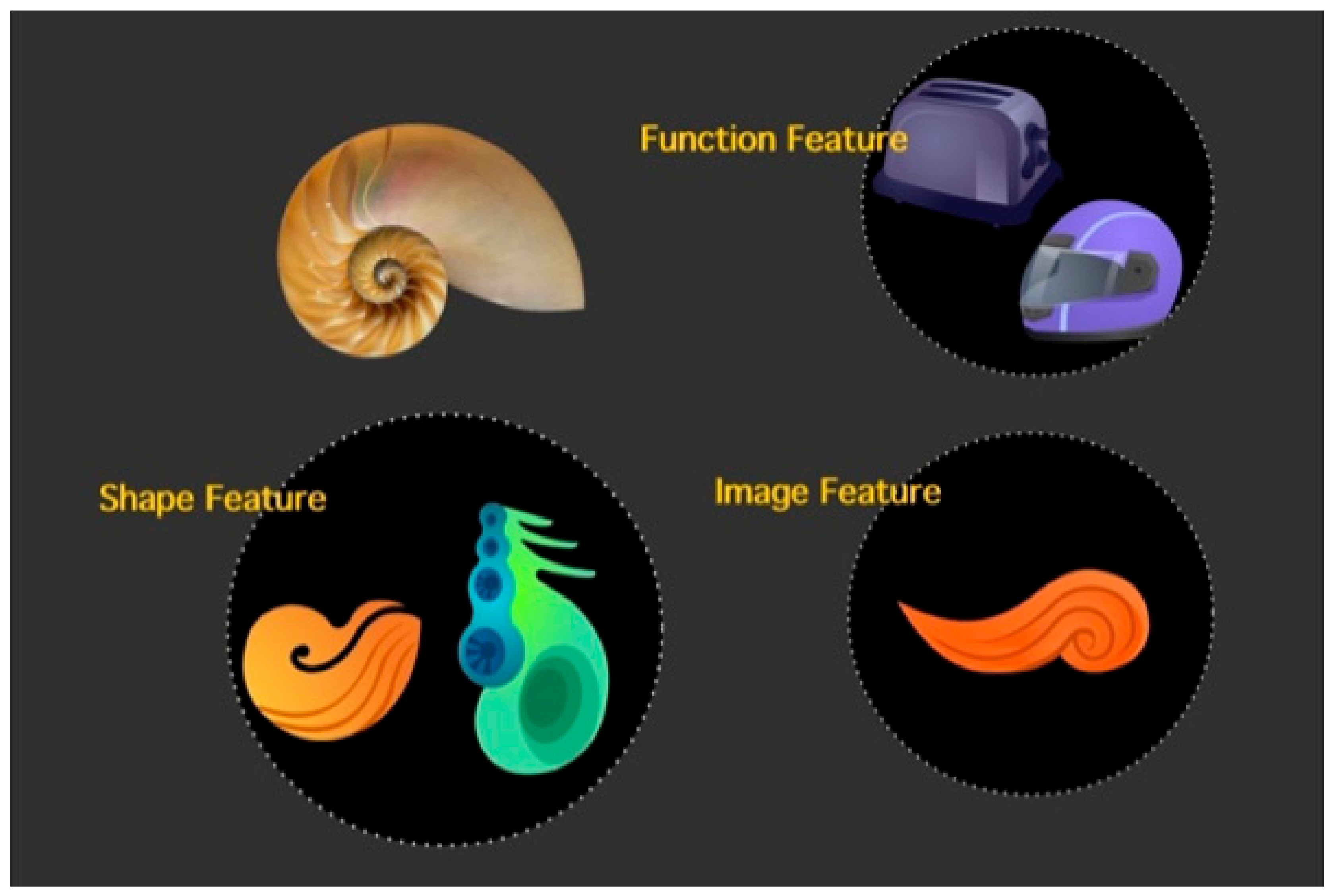
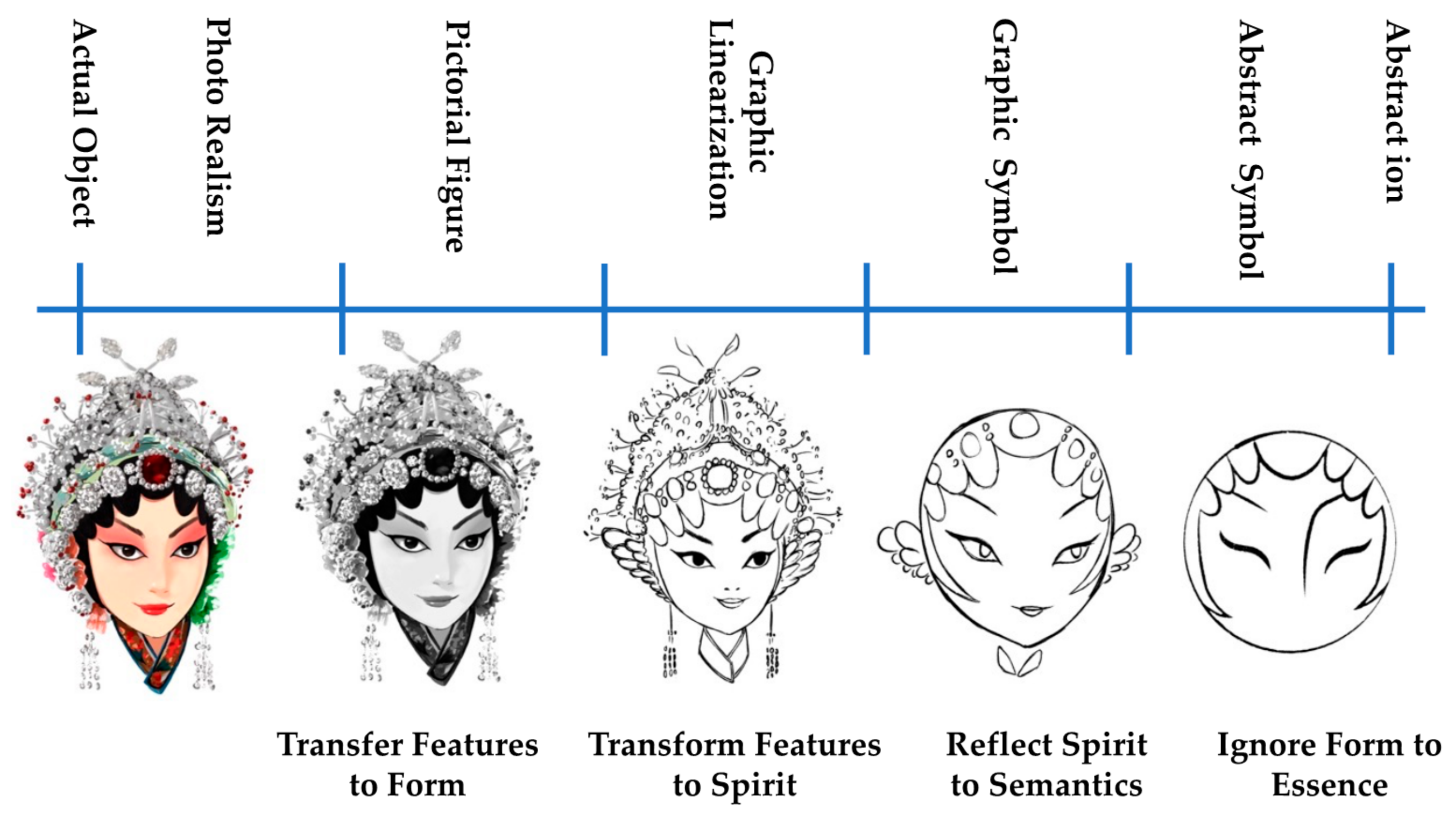
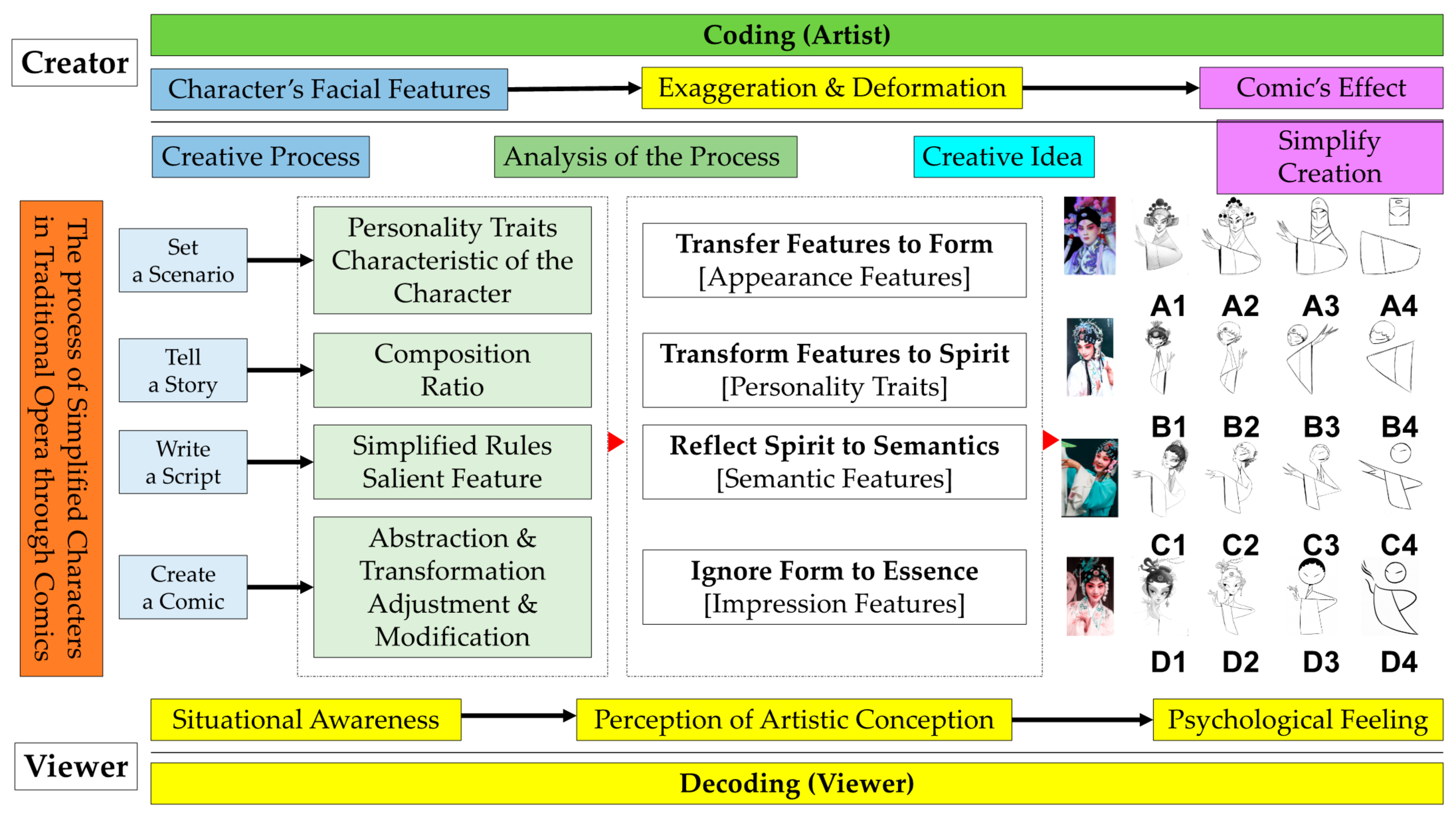
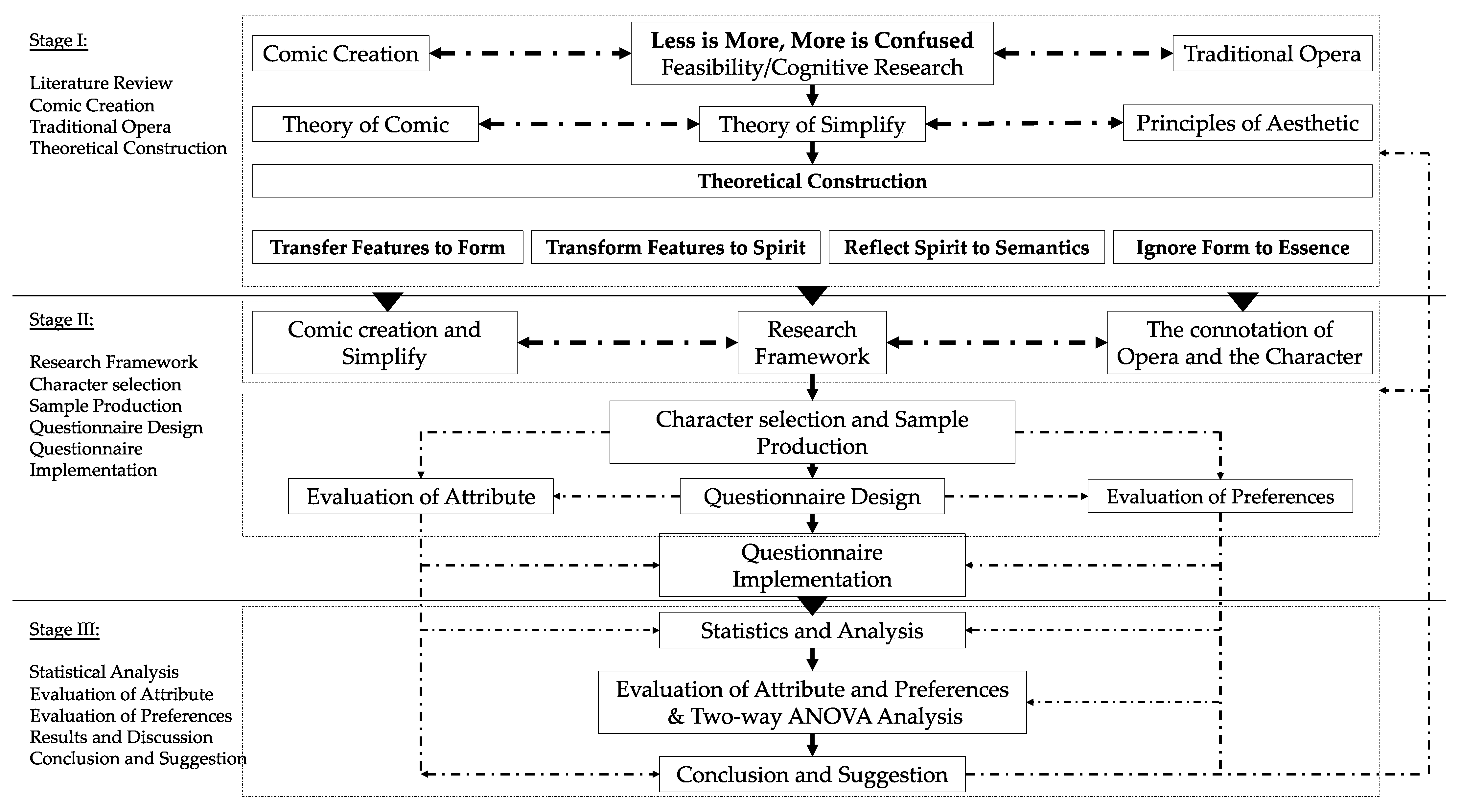



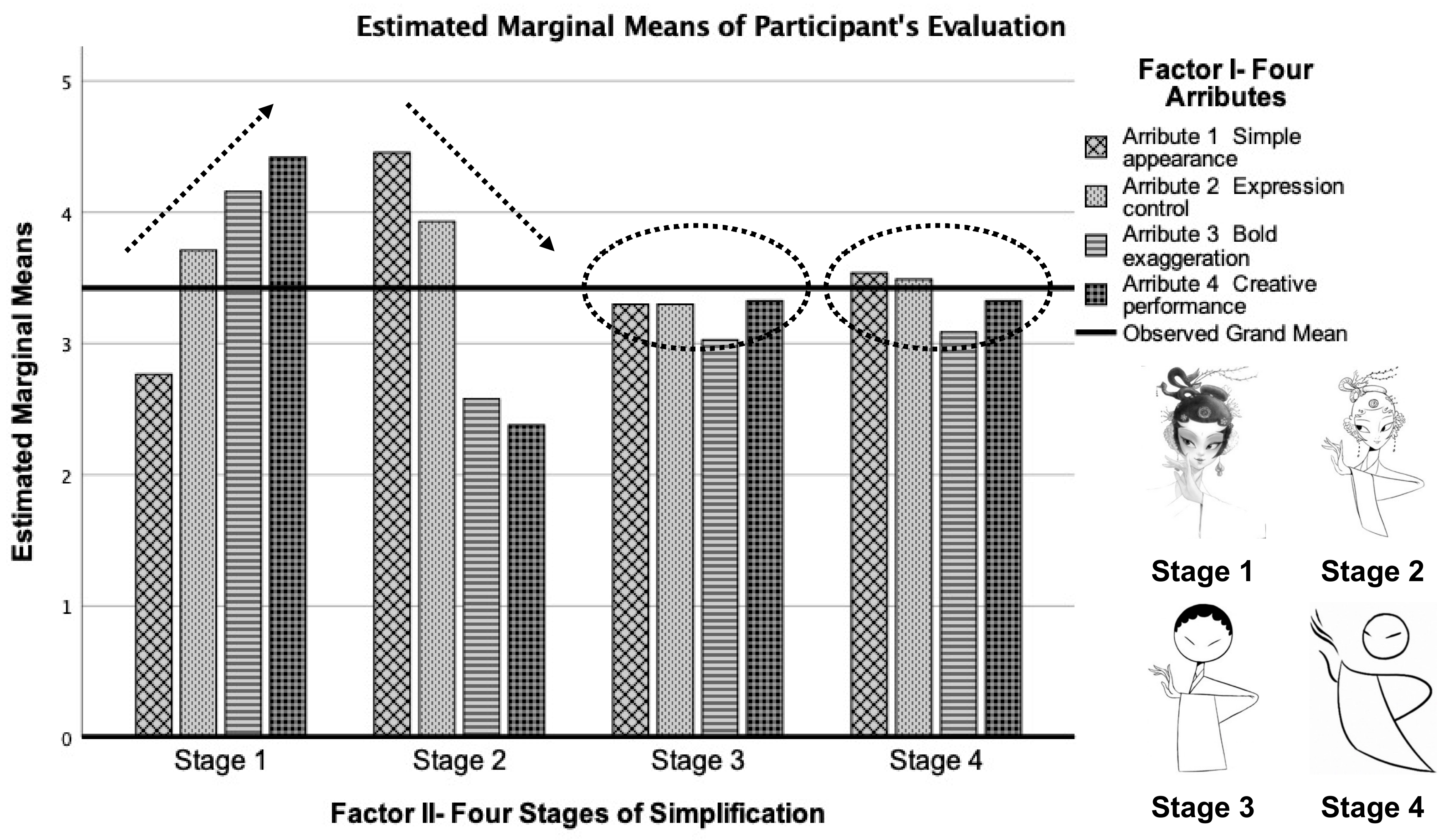

| ARTIST (CODING) | ||||
|---|---|---|---|---|
| Performance Inspiration | Processes Ideation | Products Implementation | ||
| Level C | C7-1: Topic and Acknowledgment | C8-1: Thought Provoking | C9-1: Emotional Resonance | Reflection Affecting |
| C7-2: Going beyond Reality | C8-2: Deep Planting | C9-2: Authentic Experience | ||
| C7-3: Affluence in Life | C8-3: Immersion | C9-3: Mental Simpatico | ||
| Level B | B4-1: Curiosity Raising | B5-1: Moving Stories | B6-1: Richly Culturally-Loaded | Realization Accuracy |
| B4-2: Desire Exploring | B5-2: Mood Changing | B6-2: Realistic Characteristics | ||
| B4-3: Emotion Stirring | B5-3: Inspiring the Atmosphere | B6-3: Role Identity | ||
| Level A | A1-1: Appropriately Captured | A2-1: Well-Paced | A3-1: Well-Defined Personalities | Recognition Attraction |
| A1-2 Creative and Clever | A2-2: Touching Plot | A3-2: Skillful and Appealing | ||
| A1-3: Video Effects | A2-3: Sensitive Settings | A3-3: Warm Touching | ||
| Aesthetic Experience | Meaningful Experience | Emotional Experience | ||
| AUDIENCE (DECODING) | ||||
| Demographic Variables | Num. (Prop.) | |
|---|---|---|
| 1. Gender | Male | 89 (39.6%) |
| Female | 136 (60.4%) | |
| 2. Age | ≤20 | 78 (34.7%) |
| 21–40 | 69 (30.7%) | |
| 41–60 | 71 (31.6%) | |
| ≥61 | 7 (3.1%) | |
| 3. Education | University | 48 (21.3%) |
| Graduate | 107 (47.6%) | |
| Other | 70 (31.1%) | |
| 4. Background | Design Related | 106 (47.1%) |
| Art Related | 30 (13.3%) | |
| Social Science | 30 (13.3%) | |
| Natural Science | 59 (26.2%) | |
| A1 | A2 | A3 | A4 | B1 | B2 | B3 | B4 | C1 | C2 | C3 | C4 | D1 | D2 | D3 | D4 | |
|---|---|---|---|---|---|---|---|---|---|---|---|---|---|---|---|---|
| Q1 | 2.73 1.157 | 3.39 0.903 | 4.08 1.114 | 4.32 1.077 | 2.79 0.953 | 3.62 0.934 | 4.10 0.879 | 4.37 0.940 | 2.72 0.958 | 3.54 0.986 | 4.03 1.159 | 4.39 1.092 | 2.76 1.164 | 3.71 1.098 | 4.16 1.404 | 4.42 1.385 |
| D4 > C4 > B4 > A4 > D3 > B3 > A3 > C3 > D2 > B2 > C2>A2 > B1 > D1 > A1 > C1 | ||||||||||||||||
| Q2 | 4.14 1.118 | 3.30 0.794 | 2.33 0.904 | 2.07 0.942 | 4.30 0.853 | 3.60 0.917 | 3.21 0.865 | 2.36 0.890 | 4.29 0.951 | 3.60 1.039 | 2.81 1.036 | 2.08 1.081 | 4.45 1.045 | 3.93 1.098 | 2.58 1.254 | 2.38 1.250 |
| D1 > B1 > C1 > A1 > D2 > C2 > B2 > A2 > B3 > C3 > D3 > D4 > B4 > A3 > C4 > A4 | ||||||||||||||||
| Q3 | 2.79 1.221 | 2.91 0.820 | 2.99 0.947 | 3.13 0.949 | 3.57 0.886 | 3.26 0.901 | 3.37 0.821 | 3.12 0.930 | 3.26 1.019 | 3.32 1.048 | 3.19 1.045 | 3.11 1.058 | 3.30 1.101 | 3.30 1.056 | 3.03 1.347 | 3.32 1.341 |
| B1 > B3 > D4 > C2 > D1 > D2 > B2 > C1 > C3 > A4 > B4 > C4 > D3 > A3 > A2 > A1 | ||||||||||||||||
| Q4 | 3.00 1.360 | 3.02 0.749 | 3.00 1.033 | 3.16 1.048 | 3.62 0.917 | 3.35 0.884 | 3.39 0.837 | 3.02 0.887 | 3.39 0.890 | 3.36 1.020 | 3.19 1.056 | 3.01 1.064 | 3.54 1.054 | 3.49 1.147 | 3.08 1.294 | 3.32 1.335 |
| B1 > D1 > D2 > B3 > C1 > C2 > B2 > D4 > C3 > A4 > D3 > A2 > B4 > C4 > A3 > A1 | ||||||||||||||||
| 1. Which image is simplified to a most appropriate degree do you think? | ||||||||||||||||
|---|---|---|---|---|---|---|---|---|---|---|---|---|---|---|---|---|
| Sample | D2 | D4 | B3 | C2 | B4 | A4 | C3 | D1 | C4 | B2 | A3 | A1 | D3 | A2 | C1 | B1 |
| Votes | 43 | 29 | 23 | 20 | 17 | 13 | 13 | 13 | 12 | 11 | 9 | 6 | 6 | 5 | 3 | 2 |
| Rates | 19.1 | 12.9 | 10.2 | 8.9 | 7.6 | 5.8 | 5.8 | 5.8 | 5.3 | 4.9 | 4.0 | 2.7 | 2.7 | 2.2 | 1.3 | 0.9 |
| 2. Which image can best express the creativity? | ||||||||||||||||
| Sample | D4 | D1 | B3 | D2 | B1 | C2 | C3 | B2 | D3 | A4 | C4 | A2 | C1 | A3 | B4 | A1 |
| Votes | 58 | 24 | 23 | 20 | 18 | 13 | 12 | 11 | 9 | 8 | 8 | 6 | 6 | 4 | 3 | 2 |
| Rates | 25.8 | 10.7 | 10.2 | 8.9 | 8.0 | 5.8 | 5.3 | 4.9 | 4.0 | 3.6 | 3.6 | 2.7 | 2.7 | 1.8 | 1.3 | 0.9 |
| 3. Which image shows the richest elements of a cartoon? | ||||||||||||||||
| Sample | D2 | D1 | B1 | B2 | D3 | C2 | C1 | A3 | C3 | A2 | D4 | A1 | A4 | B3 | B4 | C4 |
| Votes | 47 | 35 | 30 | 21 | 19 | 16 | 13 | 10 | 8 | 6 | 6 | 4 | 3 | 3 | 2 | 2 |
| Rates | 20.9 | 15.6 | 13.3 | 9.3 | 8.4 | 7.1 | 5.8 | 4.4 | 3.6 | 2.7 | 2.7 | 1.8 | 1.3 | 1.3 | 0.9 | 0.9 |
| 4. Which image has the best overall expression? | ||||||||||||||||
| Sample | D1 | D2 | B1 | A1 | C1 | C2 | B2 | A2 | B3 | D4 | B4 | D3 | A3 | A4 | C3 | C3 |
| Votes | 90 | 41 | 24 | 13 | 13 | 12 | 9 | 5 | 5 | 5 | 3 | 2 | 1 | 1 | 1 | 0 |
| Rates | 40 | 18.2 | 10.7 | 5.8 | 5.8 | 5.3 | 4.0 | 2.2 | 2.2 | 2.2 | 1.3 | 0.9 | 0.4 | 0.4 | 0.4 | 0 |
| 5. Which image you like best in terms of expression approach? | ||||||||||||||||
| Sample | D1 | D2 | B1 | D4 | C2 | B2 | C1 | B3 | A1 | B4 | A2 | C3 | D3 | A3 | A4 | C4 |
| Votes | 61 | 41 | 18 | 18 | 15 | 14 | 13 | 12 | 8 | 7 | 5 | 4 | 4 | 3 | 1 | 1 |
| Rates | 27.1 | 18.2 | 8.0 | 8.0 | 6.7 | 6.2 | 5.8 | 5.3 | 3.6 | 3.1 | 2.2 | 1.8 | 1.8 | 1.3 | 0.4 | 0.4 |
| 6. Which image do you think stresses the resemblance of “form” on the basis of form? | ||||||||||||||||
| Sample | D4 | D1 | A1 | D2 | B3 | A4 | C1 | C4 | A2 | A3 | B4 | B2 | C3 | B1 | D3 | D4 |
| Votes | 42 | 38 | 19 | 19 | 12 | 11 | 11 | 11 | 10 | 10 | 10 | 9 | 9 | 5 | 5 | 42 |
| Rates | 18.7 | 16.9 | 8.4 | 8.4 | 5.3 | 4.9 | 4.9 | 4.9 | 4.4 | 4.4 | 4.4 | 4.0 | 4.0 | 2.2 | 2.2 | 18.7 |
| 7. Which image convey the spirit with the use of skillful techniques and emotional experience? | ||||||||||||||||
| Sample | D1 | D2 | C1 | B1 | B2 | A1 | C2 | B3 | D4 | B4 | A2 | A3 | D3 | C3 | A4 | C4 |
| Votes | 81 | 30 | 26 | 17 | 15 | 13 | 12 | 7 | 7 | 5 | 3 | 3 | 3 | 2 | 1 | 0 |
| Rates | 36 | 13.3 | 11.6 | 7.6 | 6.7 | 5.8 | 5.3 | 3.1 | 3.1 | 2.2 | 1.3 | 1.3 | 1.3 | 0.9 | 0.4 | 0 |
| 8. Which image highlights the cultural characteristics by forming visual images of symbols through form and spirit? | ||||||||||||||||
| Sample | D1 | D4 | D2 | A1 | A2 | B1 | B3 | C1 | D3 | A4 | A3 | B4 | C2 | B2 | C3 | C4 |
| Votes | 39 | 35 | 27 | 20 | 14 | 12 | 11 | 10 | 10 | 9 | 8 | 8 | 8 | 6 | 5 | 3 |
| Rates | 17.3 | 15.6 | 12 | 8.9 | 6.2 | 5.3 | 4.9 | 4.4 | 4.4 | 4.0 | 3.6 | 3.6 | 3.6 | 2.7 | 2.2 | 1.3 |
| 9. Which image reflects the conception and neglects the form and becomes an objective symbolic image? | ||||||||||||||||
| Sample | D4 | B4 | A4 | C4 | D1 | B3 | D3 | C1 | D2 | A1 | B2 | C3 | C2 | A2 | A3 | B1 |
| Votes | 69 | 26 | 25 | 18 | 13 | 12 | 10 | 8 | 8 | 7 | 6 | 6 | 5 | 4 | 4 | 3 |
| Rates | 30.7 | 11.6 | 11.1 | 8.0 | 5.8 | 5.3 | 4.4 | 3.6 | 3.6 | 3.1 | 2.7 | 2.7 | 2.2 | 1.8 | 1.8 | 1.3 |
| Question | Sample |
|---|---|
| D2 |
| D4 |
| D2 |
| D1 |
| D1 |
| D4 |
| D1 |
| D1 |
| D4 |
| Dependent Variable: Participant’s Evaluation | |||||
|---|---|---|---|---|---|
| Source | SS Type III | df | MS | F | Sig. |
| Corrected Model | 1239.149a | 15 | 82.610 | 74.888 *** | 0.000 |
| Intercept | 42,182.314 | 1 | 42,182.314 | 38,239.526 *** | 0.000 |
| Factor I | 81.559 | 3 | 27.186 | 24.645 *** | 0.000 |
| Factor II | 145.570 | 3 | 48.523 | 43.988 *** | 0.000 |
| Factor I x Factor II | 1012.020 | 9 | 112.447 | 101.936 *** | 0.000 |
| Error | 3953.538 | 3584 | 1.103 | ||
| Total | 47,375.000 | 3600 | |||
| Corrected Total | 5192.686 | 3599 | |||
| Source of Variable | Sum of Squares | df | MS | F | Sig. | |
|---|---|---|---|---|---|---|
| Factor I-4 Attributes | Stage 1 | 335.587 | 3 | 111.862 | 97.760 *** | 0.000 |
| Stage 2 | 50.404 | 3 | 16.801 | 21.618 *** | 0.000 | |
| Stage 3 | 302.209 | 3 | 100.736 | 98.787 *** | 0.000 | |
| Stage 4 | 469.390 | 3 | 156.463 | 106.346 *** | 0.000 | |
| Factor II-4 Stages of Simplification | Attribute 1 | 356.093 | 3 | 118.698 | 103.354 *** | 0.000 |
| Attribute 2 | 695.932 | 3 | 231.977 | 250.907 *** | 0.000 | |
| Attribute 3 | 13.337 | 3 | 4.446 | 3.900 ** | 0.009 | |
| Attribute 4 | 28.217 | 3 | 9.406 | 7.840 *** | 0.000 | |
Publisher’s Note: MDPI stays neutral with regard to jurisdictional claims in published maps and institutional affiliations. |
© 2022 by the authors. Licensee MDPI, Basel, Switzerland. This article is an open access article distributed under the terms and conditions of the Creative Commons Attribution (CC BY) license (https://creativecommons.org/licenses/by/4.0/).
Share and Cite
Wu, J.; Sun, Y.; Lin, R.-T. Less Is More: Audience Cognition of Comic Simplification in the Characters of Peking Opera. Sci 2022, 4, 2. https://doi.org/10.3390/sci4010002
Wu J, Sun Y, Lin R-T. Less Is More: Audience Cognition of Comic Simplification in the Characters of Peking Opera. Sci. 2022; 4(1):2. https://doi.org/10.3390/sci4010002
Chicago/Turabian StyleWu, Jiede, Yikang Sun, and Rung-Tai Lin. 2022. "Less Is More: Audience Cognition of Comic Simplification in the Characters of Peking Opera" Sci 4, no. 1: 2. https://doi.org/10.3390/sci4010002
APA StyleWu, J., Sun, Y., & Lin, R.-T. (2022). Less Is More: Audience Cognition of Comic Simplification in the Characters of Peking Opera. Sci, 4(1), 2. https://doi.org/10.3390/sci4010002








